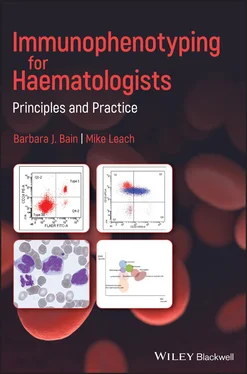St Mary’s Hospital Campus, Imperial College London
and Honorary Consultant Haematologist
St Mary’s Hospital, London, UK
Mike Leach, MB ChB, FRCP, FRCPath
Consultant Haematologist and Honorary Senior Lecturer
Haematology Laboratories and West of Scotland Cancer Centre
Gartnavel General Hospital, Glasgow, UK

This edition first published 2021
© 2021 John Wiley & Sons Ltd
All rights reserved. No part of this publication may be reproduced, stored in a retrieval system, or transmitted, in any form or by any means, electronic, mechanical, photocopying, recording or otherwise, except as permitted by law. Advice on how to obtain permission to reuse material from this title is available at http://www.wiley.com/go/permissions.
The right of Barbara J. Bain and Mike Leach to be identified as the authors of this work has been asserted in accordance with law.
Registered Office(s) John Wiley & Sons, Inc., 111 River Street, Hoboken, NJ 07030, USA John Wiley & Sons Ltd, The Atrium, Southern Gate, Chichester, West Sussex, PO19 8SQ, UK
Editorial Office 9600 Garsington Road, Oxford, OX4 2DQ, UK
For details of our global editorial offices, customer services, and more information about Wiley products visit us at www.wiley.com.
Wiley also publishes its books in a variety of electronic formats and by print‐on‐demand. Some content that appears in standard print versions of this book may not be available in other formats.
Limit of Liability/Disclaimer of Warranty The contents of this work are intended to further general scientific research, understanding, and discussion only and are not intended and should not be relied upon as recommending or promoting scientific method, diagnosis, or treatment by physicians for any particular patient. In view of ongoing research, equipment modifications, changes in governmental regulations, and the constant flow of information relating to the use of medicines, equipment, and devices, the reader is urged to review and evaluate the information provided in the package insert or instructions for each medicine, equipment, or device for, among other things, any changes in the instructions or indication of usage and for added warnings and precautions. While the publisher and authors have used their best efforts in preparing this work, they make no representations or warranties with respect to the accuracy or completeness of the contents of this work and specifically disclaim all warranties, including without limitation any implied warranties of merchantability or fitness for a particular purpose. No warranty may be created or extended by sales representatives, written sales materials, or promotional statements for this work. The fact that an organization, website, or product is referred to in this work as a citation and/or potential source of further information does not mean that the publisher and authors endorse the information or services the organization, website, or product may provide or recommendations it may make. This work is sold with the understanding that the publisher is not engaged in rendering professional services. The advice and strategies contained herein may not be suitable for your situation. You should consult with a specialist where appropriate. Further, readers should be aware that websites listed in this work may have changed or disappeared between when this work was written and when it is read. Neither the publisher nor authors shall be liable for any loss of profit or any other commercial damages, including but not limited to special, incidental, consequential, or other damages.
Library of Congress Cataloging‐in‐Publication Data
Names: Bain, Barbara J., author. | Leach, Mike, (Haematologist), author.
Title: Immunophenotyping for haematologists : principles and practice / Barbara J. Bain, Mike Leach.
Other titles: Immunophenotyping for hematologists
Description: Hoboken, NJ : Wiley‐Blackwell, 2020. | Includes bibliographical references and index.
Identifiers: LCCN 2020021078 (print) | LCCN 2020021079 (ebook) | ISBN 9781119606116 (hardback) | ISBN 9781119606147 (adobe pdf) | ISBN 9781119606154 (epub)
Subjects: MESH: Immunophenotyping | Hematologic Tests
Classification: LCC QR187.I486 (print) | LCC QR187.I486 (ebook) | NLM QW 525.5.I36 | DDC 616.07/582–dc23
LC record available at https://lccn.loc.gov/2020021078LC ebook record available at https://lccn.loc.gov/2020021079
Cover Design: Wiley
Cover Images: (background) © KTSDESIGN/SCIENCE PHOTO LIBRARY/ Getty Images, (inset) courtesy of Mike Leach
The increasing centralisation of specialised tests and the divorce of clinical from laboratory haematology in many countries means that many haematologists now have no direct contact with an immunophenotyping laboratory. Despite this, the results from the laboratory are often crucial in the management of their patients. This book is intended to help haematologists and trainees understand and interpret immunophenotyping results. It is not directed at those working in an immunophenotyping laboratory and technical details are therefore outlined only briefly. Such laboratories may, however, find it a useful source of information. For further reading on the subject, see the bibliography of each chapter.
Barbara J. Bain and Mike Leach
We should like to thank Allyson Doig, Senior Biomedical Scientist, Gartnavel Hospital, for assistance with the flow cytometry plots in Part 4.
Abbreviations Used in the Book
κkappa (light chain)λlambda (light chain)ALCLanaplastic large cell lymphomaALLacute lymphoblastic leukaemiaAMLacute myeloid leukaemiaAMoLacute monoblastic/monocytic leukaemiaAPCallophycocyanineAPLacute promyelocytic leukaemiaASTaspartate transaminaseATLLadult T‐cell leukaemia lymphomaccytoplasmicCAR T cellschimaeric antigen receptor T cellsCDcluster of differentiationCLLchronic lymphocytic leukaemiaCMLchronic myeloid leukaemiaCMMLchronic myelomonocytic leukaemiaCSFcerebrospinal fluidCTcomputed tomographyDLBCLdiffuse large B‐cell lymphomaDNAdeoxyribonucleic acidEBNAEpstein–Barr virus nuclear antigenEBVEpstein–Barr virusEMAepithelial membrane antigenETP‐ALLearly T‐cell precursor acute lymphoblastic leukaemiaFBCfull blood countFISHfluorescence in situ hybridisationFITCfluorescein isothiocyanateFLAERfluorescent aerolysinFSCforward scatter (of light)G‐CSFgranulocyte colony‐stimulating factorGPIglycosylphosphatidylinositolHbhaemoglobin concentrationHHVhuman herpesvirusHIVhuman immunodeficiency virusHLAhuman leucocyte antigenHLHhaemophagocytic lymphohistiocytosisHTLV‐1human lymphotropic virus 1IgimmunoglobulinILinterleukinLDHlactate dehydrogenaseLGLLlarge granular lymphocytic leukaemiaLMPlatent membrane proteinLLlymphoblastic lymphomaMALTmucosa‐associated lymphoid tissueMDSmyelodysplastic syndromeMDS/MPNmyelodysplastic/myeloproliferative neoplasmMoAbmonoclonal antibodyMPALmixed phenotype acute leukaemiaMPNmyeloproliferative neoplasmMPOmyeloperoxidaseMRDminimal residual diseaseNHLnon‐Hodgkin lymphomaNKnatural killerNRnormal rangePEphycoerythrinPerCPperidinin chlorophyllPLLprolymphocytic leukaemiaPNHparoxysmal nocturnal haemoglobinuriaRNAribonucleic acidSmsurface membraneSSCside or sideways scatter (of light)TCRT‐cell receptorTdTterminal deoxynucleotidyl transferaseULNupper limit of normalWBCwhite blood cell countWHOWorld Health Organization
Part 1 Purpose and Principles of Immunophenotyping
Читать дальше













